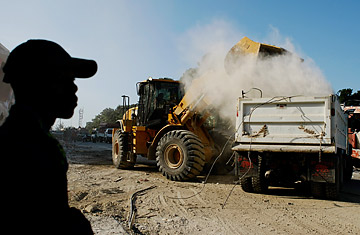
Debris is lifted onto a truck in Port-au-Prince, Haiti
Sitting alongside a pool of water, the women wash their clothes in oversize tin basins. But the sound of water sloshing against stone washboards is drowned out by the monstrous trucks transporting tons of rubble produced by the Jan. 12 earthquake. Rivière Grise, stretching from La Viste national park, to the south of Port-au-Prince, to the capital's bay, has become an illegal dumping site for debris. "They usually come at night to dump the rubble. They used to dump during the day, but then we started to run after them," says Jesner Jeanjul, 47, who has lived in the area known as Ti Moulin all her life. Jeanjul says she would wake up each morning and there would be new piles of rubble in the riverbed. Merely a trickle at present, the waterway usually overflows during heavy rains — and locals are afraid of catastrophe now that its course is obstructed with huge pieces of concrete and rock.
"Debris could significantly change the flow of the river and could create flooded rivers that overflow to make more banks," says Scott Solberg, director of Sun Mountain International, a socioeconomic-development and environmental organization. He says that the potential new channels can cause flash floods, which could wipe out entire tent cities during what is anticipated to be an active hurricane season.
But there is so much debris to dispose of — 20 million to 25 million cubic yards (15 million to 19 million cubic meters), enough to fill the Louisiana Superdome five times — and only one approved dumping site for the entire country, the Port-au-Prince terminal Varreux. "They are dumping randomly everywhere," says Dan Strode, operations manger of rubble removal for the Cooperative Housing Foundation (CHF), a project funded by USAID to clear streets and collapsed homes.
CHF has removed about 70,000 cubic meters of debris, the equivalent of 28 Olympic-size swimming pools, from Port-au-Prince and the Petit-Goave-Leogane corridor, about 40 miles from Varreux. Strode says his drivers were paid by the truckload, so initially they dumped anywhere they could in order to make more trips and even more money. A new system is in place in which drivers must get approved signatures at the dumping site before returning to collect more debris. The organization has considered installing GPS in the trucks to guarantee dumping at the approved site.
At Varreux, guards wave through trucks to empty their debris on existing piles. Some of the rubble is dumped directly into the port, ostensibly for land reclamation. Eric Overvest, country director for the United Nations Development Program (UNDP), says the lack of multiple sites impedes the already slow debris-removal process. "There's been very little rubble removal," says Overst. "The whole undertaking requires government leadership. It requires a government that designs a plan and a strategy of how to go about this."
Chief Haitian government adviser on debris management Gerard-Emile "Aby" Brun says potential sites have already been identified in the northern eminent-domain territory of Source Puante, which is scheduled to be approved by next week. "The big problem is not so much the site but that the money is not there," says Brun. He says there are an insufficient number of debris-removal contracts, and if the international community considers debris removal an urgent matter, there should be more funds to facilitate it.
International donors pledged $5.3 billion for Haiti's reconstruction over the next two years, but only Brazil has met its pledge of $55 million. The U.S. government has spent $70 million on debris-removal projects, including a cash-for-work program in which local Haitians are paid 180 gourdes ($4.50) a day to manually pick up rubble. With such an enormous undertaking, experts estimate that complete debris removal could take years. Even with 1,000 dumping trips a day, it would still take more than three years to clear all the debris, according to the UNDP.
But it could take even longer if there's no leadership, says Mike Center, acting director of the U.N.'s Project Management Coordination Cell, which works with international donors and the Haitian government. "There's a void of leadership," says Center. "We need a methodical approach not diverted by short-term needs." Without a human face attached to it, Center says, debris can be a tough sell to donors. But without addressing debris removal, he adds, the shelter crisis and flooding will not be ameliorated and the situation will worsen. Says Center: "Rubble is in the way of everything."
